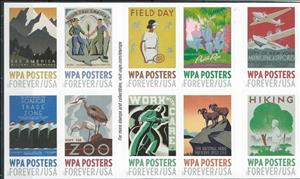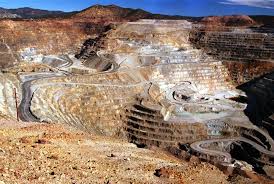Se-tenant: Posters of the Works Projects Administration (United States of America 2017)
Posters of the Works Projects Administration (United States of America 2017)
07 March (United States of America ) within release WPA Posters goes into circulation Se-tenant Posters of the Works Projects Administration face value 3.92 United States dollar
| Se-tenant Posters of the Works Projects Administration in catalogues | |
|---|---|
| Stamp Number: | Sn: US 5189a |
Se-tenant is square format.
Issued in double-sided booklet panes of 2 sets of 10, one side containing a full set and 2 from the second set, the other side having the balance of 8 stamps in the set.Also in the issue WPA Posters:
- Stamp - WPA Posters: Work Pays America face value FOREVER;
- Stamp - WPA Posters: Hiking face value FOREVER;
- Stamp - WPA Posters: Municipal Airports face value FOREVER;
- Stamp - WPA Posters: Puerto Rico face value FOREVER;
- Stamp - WPA Posters: National Parks face value FOREVER;
- Stamp - WPA Posters: Field Day face value FOREVER;
- Stamp - WPA Posters: Visit The Zoo face value FOREVER;
- Stamp - WPA Posters: Work with Care face value FOREVER;
- Booklet - WPA Posters booklet face value 20*FOREVER;
- Stamp - WPA Posters: Foreign Trade Zone face value FOREVER;
- Stamp - WPA Posters: See America face value FOREVER;
- Se-tenant - Posters of the Works Projects Administration face value 3.92;
- Stamp - WPA Posters: See America face value FOREVER;
- Stamp - WPA Posters: Foreign Trade Zone face value FOREVER;
Se-tenant Posters of the Works Projects Administration it reflects the thematic directions:
An aircraft (pl. aircraft) is a vehicle that is able to fly by gaining support from the air. It counters the force of gravity by using either static lift or the dynamic lift of an airfoil, or, in a few cases, direct downward thrust from its engines. Common examples of aircraft include airplanes, rotorcraft (including helicopters), airships (including blimps), gliders, paramotors, and hot air balloons.Part 1 (Definitions and Abbreviations) of Subchapter A of Chapter I of Title 14 of the U. S. Code of Federal Regulations states that aircraft "means a device that is used or intended to be used for flight in the air."
Animals are multicellular, eukaryotic organisms of the kingdom Animalia (also called Metazoa). All animals are motile, meaning they can move spontaneously and independently, at some point in their lives. Their body plan eventually becomes fixed as they develop, although some undergo a process of metamorphosis later on in their lives. All animals are heterotrophs: they must ingest other organisms or their products for sustenance.
Birds (Aves), a subgroup of Reptiles, are the last living examples of Dinosaurs. They are a group of endothermic vertebrates, characterised by feathers, toothless beaked jaws, the laying of hard-shelled eggs, a high metabolic rate, a four-chambered heart, and a strong yet lightweight skeleton. Birds live worldwide and range in size from the 5 cm (2 in) bee hummingbird to the 2.75 m (9 ft) ostrich. They rank as the class of tetrapods with the most living species, at approximately ten thousand, with more than half of these being passerines, sometimes known as perching birds. Birds are the closest living relatives of crocodilians.
A landscape is the visible features of an area of land, its landforms and how they integrate with natural or man-made features. A landscape includes the physical elements of geophysically defined landforms such as (ice-capped) mountains, hills, water bodies such as rivers, lakes, ponds and the sea, living elements of land cover including indigenous vegetation, human elements including different forms of land use, buildings and structures, and transitory elements such as lighting and weather conditions. Combining both their physical origins and the cultural overlay of human presence, often created over millennia, landscapes reflect a living synthesis of people and place that is vital to local and national identity. The character of a landscape helps define the self-image of the people who inhabit it and a sense of place that differentiates one region from other regions. It is the dynamic backdrop to people’s lives. Landscape can be as varied as farmland, a landscape park, or wilderness. The earth has a vast range of landscapes, including the icy landscapes of polar regions, mountainous landscapes, vast arid desert landscapes, islands and coastal landscapes, densely forested or wooded landscapes including past boreal forests and tropical rainforests, and agricultural landscapes of temperate and tropical regions.
A miner is a person who extracts ore, coal, chalk, clay, or other minerals from the earth through mining. There are two senses in which the term is used. In its narrowest sense, a miner is someone who works at the rock face; cutting, blasting, or otherwise working and removing the rock. In a broader sense, a "miner" is anyone working within a mine, not just a worker at the rock face
Tennis is a racket sport that is played either individually against a single opponent (singles) or between two teams of two players each (doubles). Each player uses a tennis racket strung with a cord to strike a hollow rubber ball covered with felt over or around a net and into the opponent's court. The object of the game is to manoeuvre the ball in such a way that the opponent is not able to play a valid return. The player unable to return the ball validly will not gain a point, while the opposite player will






